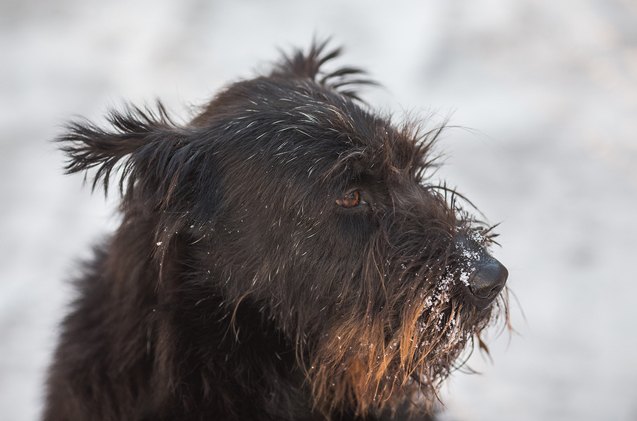Giant Schnoodle


About Giant Schnoodle
The Giant Schnoodle brings the alert and curious nature of the Standard Poodle together with the bold, protective personality of the Giant Schnauzer for a wonderfully loyal and fun family dog who loves nothing better than to spend the day hiking or playing with his human pack, then cuddling up close on the sofa at night. He isn’t big on barking but is cautious with strangers and will easily step into the role of watchdog when he feels it’s necessary.
The Giant Schnoodle is a hybrid of a Standard Poodle and a Giant Schnauzer.
Designer dogs originated in the 1980s with the intent of drawing out the best features and characteristics of two pure-bred dogs. In the case of the Giant Schnoodle, this includes the physical features and personality traits of two intelligent, low-shedding dogs; the Standard Poodle that dates back to the 1500’s and was used as hunting dog in Germany and the Giant Schnauzer who also hales from Germany where in the early 1900’s he was used as a guard dog and to drive cattle.
As a cross-bred dog, the Giant Schnoodle can’t join the elite American Kennel Club (AKC), but his parents sure did! The Giant Schnauzer joined the “working” group back in 1930 and is described as “alert, loyal and trainable” while the Poodle joined the “sporting group” back in 1887 and is pegged as being “very smart, proud and active”.
The Giant Schnoodle is a low maintenance dog with the soft, wavy coat.
Just because he’s called a Giant doesn’t mean he gets to eat like one. Your Giant Schnoodle needs a top quality kibble that provides the vitamins and nutrients needed for a dog his size and activity level. Avoid carbs and grains that may cause him to over-eat to feel full and plan to space feedings throughout the day versus free-feeding. Because he is part Poodle, he may be prone to digestive issues including pancreatitis when he hits middle age so no high fat meals or treats.
The Giant Schnoodle comes from two highly intelligent breeds that are quick to pick up on commands but have a stubborn streak so a firm hand and consistent approach may be needed. While he is great with kids he can be a bit put-off by other dogs so early socialization is important with lots of verbal praise and rewards-based training being the ideal method for this pooch.
The weight of a Giant Schnoodle ranges between 60 and 85 pounds.
Giant Schnoodles are goofy, fun-loving dogs who learn quickly and display tremendous affection and loyalty – often to one family member over others. They need regular activity to keep them from becoming bored and destructive and don’t do well when left on their own for long periods of time. Their willingness to bark as necessary makes them a great, non-aggressive watchdog. Be forewarned, he’s a cuddler so clear space on the sofa!
Cross-bred dogs are typically exempt of the health issues that impact their parents however it’s important to know what your pooch could inherit. With the Giant Schnoodle this could mean ailments such as Cushings, Addison’s Disease, epilepsy, bloat and joint issues.
The average life span of a Giant Schnoodle is 10 to 13 years.
This “giant” boy needs an active owner who can take him out for a good long walk, run or hike each day. Because he is a smart breed, these outdoor activities are important to not only keep him physically fit but mentally stimulated and thereby out of mischief. He is a social dog so adding visits to the dog park and rigorous playtime to his exercise regimen will be right up his alley.
Giant Schnoodles are goofy, fun-loving dogs who display tremendous affection.
Also known as Giant Schnauzerpoo and Giant Schnauzerdoodle, the Giant Schnoodle is not recognized by the American Kennel Club however he is recognized by the Dog Registry of America, Inc. (DRA), the Amrican Canine Hybrid Club (ACHC), Designer Breed Registry (DBR), Designer Dogs Kennel Club (DDKC) and the International Designer Canine Registry (IDCR).
The Giant Schnoodle is a low maintenance dog with the soft, wavy coat of a Standard Poodle and the low-shedding characteristics of both breeds. Brushing once or twice a week should be sufficient to keep him looking his best, with periodic trimming of his beard and stripping to maintain his coat shape. If his coat leans more towards the curly Poodle, he will need clipping every couple of months. Because he is a floppy eared dog, ear inspection and cleaning should be part of his weekly grooming ritual.
Because of some of the health issues your Giant Schnoodle could inherit, you should ask the breeder for health clearance documents from the Orthopedic Foundation for Animals (OFA) for hip dysplasia (with a score of fair or better), elbow dysplasia, hypothyroidism, and von Willebrand’s disease; from Auburn University for thrombopathia; and from the Canine Eye Registry Foundation (CERF) certifying that eyes are normal.
Photo credit: Saharrr/Bigstock; volgariver/Depositphotos; lekcej/Depositphotos

Sharing space with three seriously judgy Schnoodles and a feline who prefers to be left alone. #LivingMyBestLife
More by Mary Simpson

























